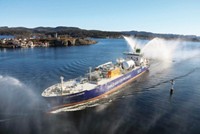Advertisement
Grab your lab coat. Let's get started
Welcome!
Welcome!
Create an account below to get 6 C&EN articles per month, receive newsletters and more - all free.
It seems this is your first time logging in online. Please enter the following information to continue.
As an ACS member you automatically get access to this site. All we need is few more details to create your reading experience.
Not you? Sign in with a different account.
Not you? Sign in with a different account.
ERROR 1
ERROR 1
ERROR 2
ERROR 2
ERROR 2
ERROR 2
ERROR 2
Password and Confirm password must match.
If you have an ACS member number, please enter it here so we can link this account to your membership. (optional)
ERROR 2
ACS values your privacy. By submitting your information, you are gaining access to C&EN and subscribing to our weekly newsletter. We use the information you provide to make your reading experience better, and we will never sell your data to third party members.
Synthesis
From C&EN Archives: Catalysis
by Ann M. Thayer
September 9, 2013
| A version of this story appeared in
Volume 91, Issue 36
Even 90 years ago, societal wants and needs were coming into conflict with natural resource availability. At the time, few realized that catalysis would enable more efficient petroleum processing to meet fuel needs and support the production of the vast majority of downstream chemical products known today. Columbia University professor Ralph H. McKee was quoted in C&EN’s first incarnation, Industrial & Engineering Chemistry News Edition (1923, 1(5), 2), saying that "petroleum production in the United States will begin to decline, probably within three years, and that it will be necessary to develop the shale fields very soon, in order to insure a domestic supply of motor fuels."
But by 1939, I&EC (1939, 17(3), 85) reported that the new catalytic cracking process, “together with the older ones, would make possible the production of gasoline for both automobiles and airplanes for the entire world from the crude reserves available in the U.S.”
In that same article, IE&C also noted that “it is estimated that the cost per mile of operating with the new gasoline will be in line with present motoring and flying costs, but a new era in automobile design will lie ahead because the superior characteristics of the new fuel will undoubtedly spur automobile engineers to design and build far better engines.”
After the promise of petroleum was realized through catalytic methods, it would take several more years before chemical processes and a wealth of new products reached any scale. “All the organic chemicals including rubber and alcohol needed to meet the entire world’s needs for a year could be made from 10 days’ crude oil production. While negligible as a volume outlet for crude oil, the petroleum-chemical field is nonetheless of extreme importance,” said Robert Price Russell, president of Standard Oil Development Co., in a report on his Cadman Memorial Lecture (C&EN, 1947, 25(24), 1737).
MORE ON THIS STORY
Introduction: Nine For Ninety | PDF
Chemical Connections | PDF
Antibacterial Boom And Bust | PDF
Small Science, Big Future | PDF
Understanding The Workings Of Life | PDF
Chemistry By The Numbers | PDF
Plastic Planet | PDF
The Catalysis Chronicles | PDF
Giving Chemists A Helping Hand | PDF
It's Not Easy Being Green | PDF
Readers' Favorite Stories | PDF
Nine Decades Of The Central Science | PDF
How Chemistry Changed the World | C&EN's 90th Anniversary Poster Timeline
Trying To Explain A Bond
A Toast To C&EN At 90




Join the conversation
Contact the reporter
Submit a Letter to the Editor for publication
Engage with us on Twitter